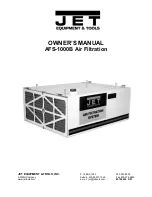
4
shipping damage is filed, the unit, shipping carton, and all
packing must be retained for physical inspection by the trans-
portation company. All units should be stored in the factory
shipping carton with internal packaging in place until installa-
tion.
PROTECTING UNITS FROM DAMAGE — Do not apply
force or pressure to the coil, piping, or drain stub-outs during
handling. All units should be handled by the chassis or as close
as possible to the unit mounting point locations.
The unit must always be properly supported. Temporary
supports used during installation or service must be adequate to
hold the unit securely. To maintain warranty, protect units
against hostile environments (such as rain, snow or extreme
temperature), theft, vandalism, and debris on jobsite. Equip-
ment covered in this manual is not suitable for outdoor installa-
tions. Do not allow foreign material to fall into drain pan. Pre-
vent dust and debris from being deposited on motor, fan wheels
and coils. Failure to do so may have serious adverse effects on
unit operation and in the case of motor and blower assembly,
may result in immediate or premature failure. Failure of any
unit caused by deposits of foreign material on the motor or
blower wheels will not be covered by the manufacturer’s war-
ranty. Some units and/or job conditions may require some form
of temporary covering during construction.
PREPARING JOBSITE FOR UNIT INSTALLATION —
To save time and to reduce the possibility of costly errors, set
up a complete sample installation in a typical room at jobsite.
Check all critical dimensions such as pipe, wire, and duct con-
nections requirements. Refer to job drawings and product
dimension drawings as required. Instruct all trades in their
parts of the installation. Units must be installed in compliance
with all applicable local code requirements.
IDENTIFYING AND PREPARING UNITS — Be sure
power requirements match available power source. Refer to
unit nameplate and wiring diagram. In addition:
• Check all tags on unit to determine if shipping screws are
to be removed. Remove screws as directed.
• Rotate the fan wheel by hand to ensure that the fan is
unrestricted and can rotate freely. Check for shipping
damage and fan obstructions. Adjust blower motor as
required.
Step 2 — Position the Unit
Select the unit position with the following points in mind:
• The unit should be installed on wall studs that are strong
enough to support the total weight of the unit, refrigerant
piping, and condensate.
• The unit should be mounted 8 ft or more from the floor
and if possible, centrally located on the wall from both
ends.
• Proper clearance should be provided on the side and top
as shown in Fig. 3.
• The unit should not be positioned directly above any
obstruction.
• The unit must be installed square and level.
• The condensate drain should have sufficient downward
slope in the condensate flow direction.
Step 3 — Mount the Unit
1.
Detach the mounting plate from the unit.
2.
Place the mounting plate on the wall where the unit will
be installed and mark the mounting holes. See Fig. 4.
Be sure the mounting hole marks are positioned over the
wall studs.
3.
Mark the condensate and refrigerant piping route. If nec-
essary, cut hole in wall to route the piping.
4.
Secure the mounting plate with screws that can support
the weight of the unit. For nominal weight of the unit, see
Table 1.
DANGER
Units must not be installed where they may be exposed to
potentially explosive or flammable atmosphere. If this
instruction is not followed exactly, a fire or explosion may
result, causing property damage, injury, or loss of life.
CAUTION
When determining the unit mounting location, make sure
that there are no water, plumbing, or electrical lines run-
ning through the wall. Failure to follow this instruction
may result in property damage.
6 in. MIN.
5 in.
MIN.
5 in.
MIN.
A40-1705
Fig. 3 — Required Clearances
Fig. 4 — Mounting Plate
NOTE: All dimensions in inches.
18-1/4
2-1/4
28
MOUNTING
PLATE
UNIT SIZES 007-012
31-3/8
28-3/4
2-5/8
UNIT SIZES 015-018
MOUNTING
PLATE






























